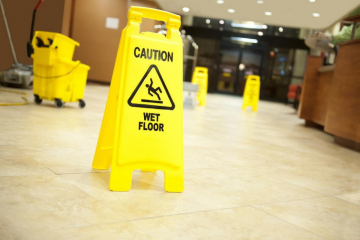Not long ago, I spent an extended time in the hospital with my father. As I stayed by his side, I was surprised to see how many potential workplace hazards and possible near-miss injuries hospital employees faced.
The staff was looking out for my father’s safety, but I wondered if they were thinking about their own safety as well. We count on physicians, nurses and healthcare assistants for safe patient handling when they are in the hospital, but who is keeping them safe?
Much attention was given so that my father would not fall while getting out of bed, and the staff washed their hands to keep him free from infections and ensured that he was the correct patient when medications were delivered.
But is the nurse who is assisting my father out of bed making sure that she isn’t vulnerable to her own back injury? When medications are being delivered, is she remembering to activate the safety mechanism on the syringe to avoid a needle stick injury? When the physician is rushing to see her next patient, is she aware that slick surfaces could cause her to fall?
Healthcare employees are always looking for the best ways to provide quality patient care, but in the end is it at the expense of their own hospital workplace safety? The care team assigned to my father probably had years of medical training to ensure he was being treated in appropriate ways. But did that training provide the awareness necessary to alert them of the potential risks that they might personally encounter while delivering care.
The reality of hospital workplace injuries
What is the real impact of an injury to a caregiver? How is the health and well-being of a patient impacted when their doctor or nurse suffers an injury in the workplace? How is the hospital as an organization impacted? Are injuries being tracked? And if so, who is accountable for ensuring they don’t recur?
In 2013, the Occupational Safety and Health Administration (OSHA) reported that a hospital is one of the most hazardous places to work. In 2019, U.S. hospitals recorded 221,400 work-related injuries and illnesses, a rate of 5.5 work-related injuries and illnesses for every 100 full-time employees. In addition, almost one-quarter of injuries sustained while working resulted in nurses missing one or more months of work. Some of these injuries not only resulted in missed days, but also limited workers' ability to continue with normal job duties.
These numbers are higher than in construction, manufacturing, and private industries. The data is staggering and the numbers would keep up any hospital CEO at night thinking: “My hospital has more injuries and illnesses keeping staff away from work than the construction site next door."
The true cost of on-the-job injuries and illnesses
According to Aon Risk Solutions, $12,000 is the average indemnity paid to injured healthcare workers in a hospital. However, when you include some of the intangible costs that these injuries can incur, the numbers are much higher. In talking with some of the care providers that assisted my family while my father was in the hospital, it was evident that my father was not their only patient. Candidly, they let me know that busy schedules and low employee satisfaction were among their top concerns.
The staff were seeing their coworkers being injured on the job. When those caregivers were out due to injuries, it had a cascading effect on the team, who had to assume greater care responsibilities until their coworker returned or a replacement was hired. Based on our conversations and the data, I believe that these tangible and intangible impacts are costing healthcare providers much more than they realize.
It is easy to quantify the simple cost of an injured worker’s financial compensation, but when coupled with the true cost of injuries, especially those that result in lost time, turnover, and associated hiring and training costs, the expenses become exponentially higher and difficult to ignore. Antea Group has found, through our own research and modeling, that the real cost of losing an employee due to an injury is closer to $60,000 per loss.
Taking steps towards safety
As an EH&S (Environment, Health, and Safety) professional, I want to turn these statistics around. Let’s start focusing on healthcare staff safety just as hospitals focus on patient safety, and work towards a unified effort to reduce these preventable healthcare costs.
In order to do this, hospitals need to explore the root causes that lead to injury. Is it lack of safety training, understanding or knowledge? Whether it is an injured back or shoulder from improperly lifting a patient, a Sharps injury from not wearing personal protective equipment, or an injured knee from tripping over a poorly placed mop bucket, hospitals should look at the trends and begin to prioritize solutions to the biggest offenders.
Building a culture of safety becomes much easier with a trusted and experienced partner who is completely up-to-date on all regulatory mandates and industry-specific risks. Contact us to learn more about whether Antea Group could be that partner for your hospital.
We owe it to our care providers.
Want more news and insights like this?
Sign up for our monthly e-newsletter, The New Leaf. Our goal is to keep you updated, educated and even a bit entertained as it relates to all things EHS and sustainability.
Get e-Newsletter



